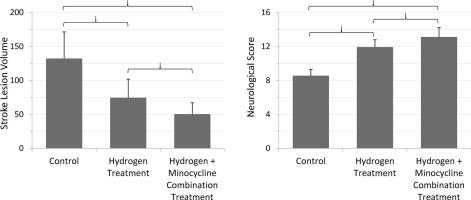Optimized dose of hydrogen-enriched water with minocycline combination therapy in experimental ischemic stroke
IF 2.6
4区 医学
Q3 NEUROSCIENCES
引用次数: 0
Abstract
Background
Ischemic stroke remains a leading cause of death and disability worldwide, with limited effective treatments due to the complexity of its pathophysiology. Molecular hydrogen (H2) and minocycline (M), both possessing anti-inflammatory and antioxidant properties, have shown individual neuroprotective potential in preclinical models. However, the optimal therapeutic dosing of H2, particularly in combination with other agents, remains undefined.
Objective
This study aimed to (1) determine the dose–response relationship of hydrogen-enriched water in a rat model of transient middle cerebral artery occlusion (MCAO), and (2) evaluate whether optimized H2 dosing combined with minocycline provides superior neuroprotection compared to H2 monotherapy.
Methods
Sixty-six male and female Sprague-Dawley rats underwent 60-minute MCAO followed by treatment with varying doses (5–30 mL/kg) of hydrogen-enriched water (3.2 ppm), alone or in combination with minocycline (20 mg/kg). Treatments were administered post-reperfusion as well as on days 1 and 2. Behavioral outcomes (Garcia score) and infarct volumes (TTC staining) were assessed at 7 days post-stroke.
Results
The optimal H2 dose was 20 mL/kg, which produced the highest Garcia scores and lowest infarct volumes. A dose-dependent effect was observed with a quadratic fit (R2 = 0.751 for Garcia scores; R2 = 0.289 for lesion volume). Combination therapy with H2 and minocycline significantly outperformed H2 monotherapy in both neurological recovery and infarct reduction, with no sex differences observed.
Conclusion
Hydrogen-enriched water shows a dose-dependent neuroprotective effect in experimental ischemic stroke, with 20 mL/kg identified as the optimal dose. Combined therapy with minocycline further enhances outcomes, supporting the potential of dual-agent strategies for improved stroke treatment. These findings provide a foundation for translational development of H2-based combination therapies in clinical settings.

富氢水联合米诺环素治疗实验性缺血性脑卒中的最佳剂量。
背景:缺血性脑卒中仍然是世界范围内死亡和残疾的主要原因,由于其病理生理的复杂性,有效的治疗有限。分子氢(H2)和米诺环素(M)都具有抗炎和抗氧化特性,在临床前模型中显示出单独的神经保护潜力。然而,H2的最佳治疗剂量,特别是与其他药物联合使用,仍未确定。目的:本研究旨在(1)确定富氢水在短暂性大脑中动脉闭塞(MCAO)大鼠模型中的剂量-反应关系;(2)评估优化后的H2剂量与米诺环素联合治疗是否比H2单药治疗具有更好的神经保护作用。方法:66只雄性和雌性Sprague-Dawley大鼠进行60分钟的MCAO,然后用不同剂量(5-30 mL/kg)的富氢水(3.2 ppm)单独或联合米诺环素(20 mg/kg)治疗。再灌注后及第1、2天给予治疗。在脑卒中后7 天评估行为结局(Garcia评分)和梗死体积(TTC染色)。结果:H2的最佳剂量为20 mL/kg,加西亚评分最高,梗死体积最小。通过二次拟合观察到剂量依赖性效应(加西亚评分R2 = 0.751;病变体积R2 = 0.289)。H2和米诺环素联合治疗在神经恢复和梗死减少方面明显优于H2单药治疗,没有观察到性别差异。结论:富氢水对实验性缺血性脑卒中具有剂量依赖性的神经保护作用,最佳剂量为20 mL/kg。与米诺环素联合治疗进一步提高了结果,支持双药策略改善脑卒中治疗的潜力。这些发现为临床环境中以h2为基础的联合疗法的转化开发提供了基础。
本文章由计算机程序翻译,如有差异,请以英文原文为准。
求助全文
约1分钟内获得全文
求助全文
来源期刊

Brain Research
医学-神经科学
CiteScore
5.90
自引率
3.40%
发文量
268
审稿时长
47 days
期刊介绍:
An international multidisciplinary journal devoted to fundamental research in the brain sciences.
Brain Research publishes papers reporting interdisciplinary investigations of nervous system structure and function that are of general interest to the international community of neuroscientists. As is evident from the journals name, its scope is broad, ranging from cellular and molecular studies through systems neuroscience, cognition and disease. Invited reviews are also published; suggestions for and inquiries about potential reviews are welcomed.
With the appearance of the final issue of the 2011 subscription, Vol. 67/1-2 (24 June 2011), Brain Research Reviews has ceased publication as a distinct journal separate from Brain Research. Review articles accepted for Brain Research are now published in that journal.
 求助内容:
求助内容: 应助结果提醒方式:
应助结果提醒方式:


